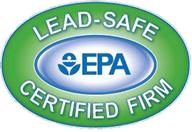RRP Question: Does Removing Aluminum Siding Fall Under the RRP Rule?
Question:

"Theoretically, aluminum siding came with paint on it…..and most was installed before 1978. Does anyone know if the factory paint on aluminum siding has lead in it? Intuitively, one would pull it off without concern for lead, but I have a client who has asked specifically."
Gregory A. Antonioli, GCP, President
Out of the Woods Construction and Cabinetry
Shawn’s Answer:
Greg:
 The rule includes all painted or coated surfaces. So yes, the siding must be assumed to have lead until tested otherwise.
The rule includes all painted or coated surfaces. So yes, the siding must be assumed to have lead until tested otherwise.
Note: My opinion as expressed above is based on the fact that the painted surface is being “disturbed”. Here is an interesting conversation about this topic on the JLC forum.
Aluminum siding during that era was manufactured by many different companies so it would not be wise to assume they all used the same paint or coating. Even if you test a product on one house and find it lead free, under the RRP Rule you must assume that same product might have lead if installed on any other building.
Here is one that might seem crazy. Along the same vein, even if you built an addition or deck at a home after 1977, and you know all the products you used were purchased and installed after 1977, if returning to work on the addition or deck you must still assume the addition or deck may contain lead. The only way around this is to test it to prove the absence of lead under the rule.
Something often missed or overlooked is if the original siding under the aluminum siding contains lead. If you have to remove that siding too or even just disturb more than 20 square feet of the old siding when removing the aluminum siding, then the RRP Rule will apply.
Here is what the EPA says at their RRP FAQ area about removing aluminum siding:
Question:
I am removing aluminum siding from a pre-1978 home. The aluminum siding was nailed over the top of painted wood siding that tested positive for lead. The underlying painted surface is greater than twenty-square feet. Must I comply with the Rule when removing the aluminum siding?
EPA Answer:
 The work practices for exterior projects are based on a performance standard – if the activity disturbs a painted surface (generally, by creating paint chips or dust) in excess of 20 square feet, the work area must be contained so that dust or debris does not leave the work area while the renovation is being performed. In this case, if the removal of the aluminum siding results in the disturbance of paint in excess of 20 square feet, then the RRP Rule applies. However, if the removal activity could be performed in such a way that does not disturb 20 square feet of painted surface, then the RRP Rule would not apply.
The work practices for exterior projects are based on a performance standard – if the activity disturbs a painted surface (generally, by creating paint chips or dust) in excess of 20 square feet, the work area must be contained so that dust or debris does not leave the work area while the renovation is being performed. In this case, if the removal of the aluminum siding results in the disturbance of paint in excess of 20 square feet, then the RRP Rule applies. However, if the removal activity could be performed in such a way that does not disturb 20 square feet of painted surface, then the RRP Rule would not apply.
EPA recognizes that this may be difficult to determine in advance of the renovation activity. However, the renovator is the person with the expertise and experience to make this determination on a case-by-case basis. In such a situation, a renovator should consider how factors like the condition of the underlying paint or the chosen method of removal may increase or decrease the likelihood for a disturbance of paint. If there is still uncertainty, EPA recommends that renovators err on the side of caution and be prepared to contain any dust and debris.

 Looking for accurate information about the EPA RRP rule?
Looking for accurate information about the EPA RRP rule? 
 Posted signs: These must be posted on all sides of the work area to define the work area, must be in the primary language of occupants, must be posted before the beginning of the renovation, and must remain until cleaning verification is achieved.
Posted signs: These must be posted on all sides of the work area to define the work area, must be in the primary language of occupants, must be posted before the beginning of the renovation, and must remain until cleaning verification is achieved. Remove or cover furniture/objects: Remove (preferred) objects like furniture, rugs, window coverings; or cover them with plastic sheeting with all seams and edges taped.
Remove or cover furniture/objects: Remove (preferred) objects like furniture, rugs, window coverings; or cover them with plastic sheeting with all seams and edges taped. Cover duct opening: Close and cover all HVAC vents in the work area with taped down plastic sheeting or other impermeable materials (e.g., magnetic covers).
Cover duct opening: Close and cover all HVAC vents in the work area with taped down plastic sheeting or other impermeable materials (e.g., magnetic covers).


 In this example, I would place 3.5 mil plastic (from Home Depot), instead of the 6 mil plastic 10 feet out on the ground. Then, I would make sure doors/windows were closed, put plastic over any doors and then put up the warning sign. I would also run a plastic runner out to the dumpster and surround the ground around the dumpster with plastic. Doing the containment this way, saves me from having to wrap, bag or HEPA vac the siding (or myself). This is because I can dump the siding without ever going outside the containment area.
In this example, I would place 3.5 mil plastic (from Home Depot), instead of the 6 mil plastic 10 feet out on the ground. Then, I would make sure doors/windows were closed, put plastic over any doors and then put up the warning sign. I would also run a plastic runner out to the dumpster and surround the ground around the dumpster with plastic. Doing the containment this way, saves me from having to wrap, bag or HEPA vac the siding (or myself). This is because I can dump the siding without ever going outside the containment area. I can demo the tile, tub, shower, toilet and remove the demolition debris without doing any RRP. After that has been done, I cover up ducts with plastic, make sure windows are closed, close doors and cover with plastic, put up a warning sign and then cover the subfloor with plastic (6 feet out from where I will be working).
I can demo the tile, tub, shower, toilet and remove the demolition debris without doing any RRP. After that has been done, I cover up ducts with plastic, make sure windows are closed, close doors and cover with plastic, put up a warning sign and then cover the subfloor with plastic (6 feet out from where I will be working).  It very well could be that if you did a little homework by reading the actual law, you could reduce the cost of compliance on many jobs to less than 5%. Few contractors will lose a job because they are higher by less than 5%. Plus, with the cost less than 5%, I don’t even mention RRP to my clients during the estimation process anymore, which has helped to improve sales.
It very well could be that if you did a little homework by reading the actual law, you could reduce the cost of compliance on many jobs to less than 5%. Few contractors will lose a job because they are higher by less than 5%. Plus, with the cost less than 5%, I don’t even mention RRP to my clients during the estimation process anymore, which has helped to improve sales. 

 There was no mention of having to wear disposable suits, dust mask, booties or headwear. (Still might need to comply with OSHA)
There was no mention of having to wear disposable suits, dust mask, booties or headwear. (Still might need to comply with OSHA) It didn’t say I had to use 6 mil plastic, which made me happy since the 3.5 mil plastic sold at Home Depot cost less.
It didn’t say I had to use 6 mil plastic, which made me happy since the 3.5 mil plastic sold at Home Depot cost less.

 While deleading activities conducted in residences and child-occupied facilities often involve work methods similar to those typically used in renovation, repair or painting (RRP) activities, such as replacing windows, painting and installing vinyl siding, the two types of activities are distinct from each other in terms of purpose and effect.
While deleading activities conducted in residences and child-occupied facilities often involve work methods similar to those typically used in renovation, repair or painting (RRP) activities, such as replacing windows, painting and installing vinyl siding, the two types of activities are distinct from each other in terms of purpose and effect. Once you have made the initial determination regarding whether your project is a renovation project or a deleading project, the next question is how to choose a contractor who is licensed and qualified to perform the work. Click on the following link to view a helpful guide on choosing a deleading contractor, “
Once you have made the initial determination regarding whether your project is a renovation project or a deleading project, the next question is how to choose a contractor who is licensed and qualified to perform the work. Click on the following link to view a helpful guide on choosing a deleading contractor, “ Hybrivet Systems, Inc. manufactures and distributes the
Hybrivet Systems, Inc. manufactures and distributes the  ESCA Tech, Inc. manufactures and distributes the
ESCA Tech, Inc. manufactures and distributes the 
 This is an excellent observation and question. The liability in such a situation is huge. I just recently had a conversation about this topic with an attorney well familiar with the RRP rule. Her suggestion was to consider asking the home owner to do testing of the occupants and perhaps even dust wipe testing at the home before beginning any work to establish a point of reference. Discussing this with and asking the home owner to do so would obviously be a sensitive conversation and could likely be a tough sell for many contractors.
This is an excellent observation and question. The liability in such a situation is huge. I just recently had a conversation about this topic with an attorney well familiar with the RRP rule. Her suggestion was to consider asking the home owner to do testing of the occupants and perhaps even dust wipe testing at the home before beginning any work to establish a point of reference. Discussing this with and asking the home owner to do so would obviously be a sensitive conversation and could likely be a tough sell for many contractors.
 Deleading under the MA Lead Law requires the removal or covering of
Deleading under the MA Lead Law requires the removal or covering of  At a recent
At a recent 



